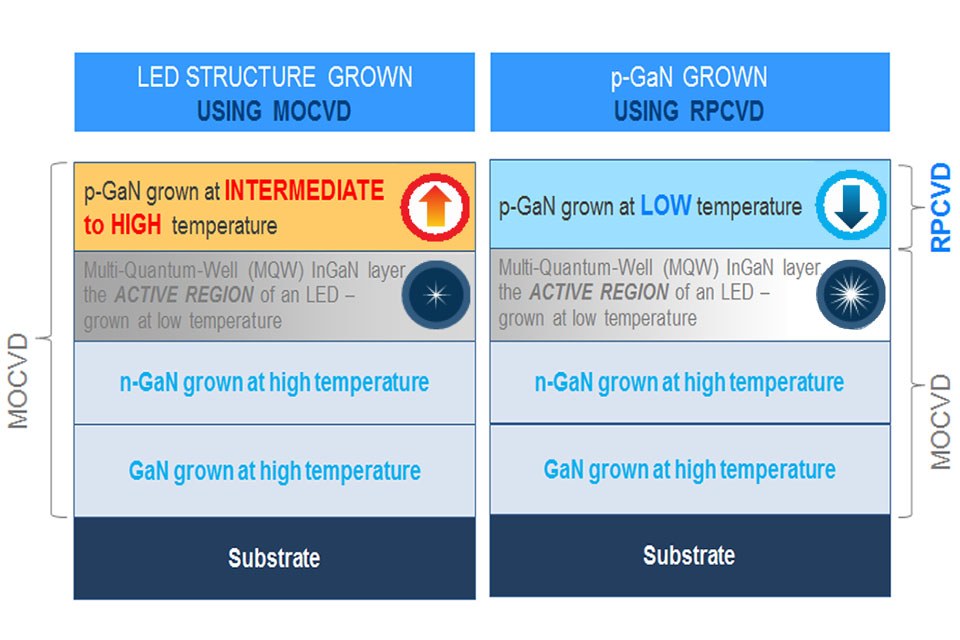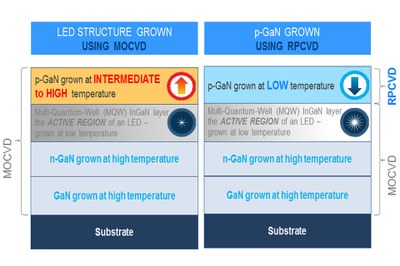Bluglass Produced p-GaN Films that Meet Industry Benchmark for the First Time
Australian clean technology innovator, BluGlass Limited (ASX: BLG) announced today that it has succeeded in producing p-type gallium nitride (GaN) films with industry equivalent electrical properties using its breakthrough low temperature Remote Plasma Chemical Vapour Deposition (RPCVD) technology when grown on top of MOCVD GaN templates.
BluGlass has successfully demonstrated p-GaN films grown at low temperature with electrical properties equivalent to films grown using the industry standard process – MOCVD. This breakthrough follows on from the company’s proof of concept milestone achievement late last year. Having demonstrated these material specifications BluGlass is now in a position to commence experiments targeting improved LED device efficiency using RPCVD grown p-GaN layers to demonstrate the commercial value of a low temperature technology.
Measurement results of RPCVD p-GaN film grown on commercial GaN Template vs. a typical MOCVD grown p-GaN film:
| Typical MOCVD p-GaN Spec. | Recent RPCVD p-Gan Data | |
|---|---|---|
| Resisitivity | ≤ 3 Ohm/cm |
1 Ohm/cm |
| Carrier Concentration | ≥ 1 x 1017 cm-3 | 2 x 1017 cm-3 |
BluGlass contracted The Australian National University (ANU), a leading university in semiconductor physics, to independently measure and verify the electrical properties of the samples. The metal contacts required to perform the electrical measurements were prepared by the Australian National Fabrication Facility (ANFF).
Giles Bourne, BluGlass CEO, said today “The technology team is making increasingly rapid progress in the development of our platform technology and technical milestones to prove the competitive advantages of the low temperature RPCVD technology.”
With a lower growth temperature than MOCVD, BluGlass’ proprietary technology, RPCVD has the potential to allow LED manufacturers to create higher performing devices by reducing the multi–quantum well or active region’s exposure to high temperatures which currently leads to a performance loss (see Figure One below).
BluGlass Chief Technology Officer Dr. Ian Mann added “The next steps will see the technology focus on demonstrating that a low temperature p-GaN layer can improve an LED’s efficiency over existing commercial devices. We aim to do this by making a test LED device using RPCVD to grow p-GaN on top of an MOCVD grown partial LED structure and to subsequently measure the light output of the device”.
For additional information, please visit www.bluglass.com.au
LED Device Terms:
p-GaN (or p-type GaN) refers to a GaN film that has been doped (i.e. the process of adding certain type of atoms - in this case with magnesium) to increase the number of free charge carriers (in this case positive holes)
n-GaN (or n-type GaN) refers to a GaN film that has been doped (i.e. the process of adding certain type of atoms - in this case with silicon) to increase the number of free charge carriers (in this case negative electrons)
About BluGlass:
BluGlass Limited is an Australian green technology company formed to commercialise a breakthrough in the Semiconductor Industry. BluGlass has invented a new process using Remote Plasma Chemical Vapour Deposition (RPCVD) to grow semiconductor materials such as gallium nitride (GaN) and indium gallium nitride (InGaN), crucial to the production of high efficiency devices such as next generation lighting technology Light Emitting Diodes (LEDs) with advanced low cost potential.
The RPCVD technology, because of its low temperature and highly flexible nature, offers many potential benefits over existing technologies including higher efficiency, lower cost and greater scalability.


